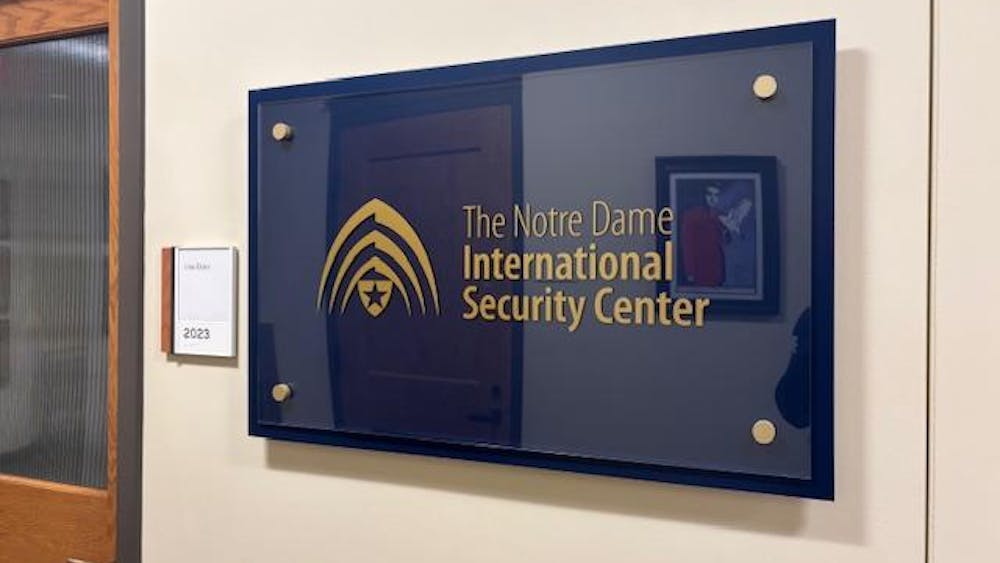On Tuesday, Julianne Wallace, the Vice President of Mission at Saint Mary’s College, gave a presentation introducing Saint Mary’s mission and identity.
Wallace started by giving a brief overview of the history and charism of the Holy Cross Congregation and how the tri-campus was initially started. The founder of the congregation of Holy Cross, Basil Moreau, was a priest in Le Mans, France, who noticed that children were not being educated because of the French Revolution.
One of Moreau’s most famous quotes is “... the mind will not be cultivated at the expense of the heart.” Wallace went on to say, “Basil Moreau was really trying to get to the understanding of education as holistic. That we can’t just bring our mind to the classroom we must bring our heart.”
Saint Mary’s was never established with the intention of being just a college for women to get an education, its aim has always been a holistic education “to prepare students to make a world better than our own.”
A unique part of Moreau’s education plan was that he wanted the men and women to be in union, because there is no religious order in the Catholic Church that has the men and women living together. At the time, the Pope wouldn’t let him do that so Moreau sent Edward Sorin, the founder of Notre Dame, to the United States to start educating. Very quickly after Sorin arrived he knew that he was going to need sisters to help begin ministry so he requested for four Maronite sisters to come, despite not speaking English, they were the beginning of the Sisters of the Holy Cross in the United States.
Wallace explained, “They originally settled at Notre Dame, but the sisters wanted a more permanent home so they moved to Bertrand, Michigan. It's interesting why they chose Bertrand because the Bishop at the time didn’t want two groups of religious women, so they moved across state lines and settled down.”
“And when the Bishop changed, Sorin asked permission for the sisters to move back to Notre Dame, and they settled across the street from Notre Dame and Saint Mary's Academy began.”
Wallace went on to discuss three very important and prominent sisters in Saint Mary’s history, referring to them as “women of wisdom.”
“We consider Saint Mary’s to be the work of many women, that's why we don’t just talk about one woman,” Wallace continued.
The first sister she mentioned was Mother Angela, who was most known for always being by Sorin’s side and making sure his visions were made out and seen true. Mother Angela was considered an intellectual and spiritual leader, who oversaw the initial transition from the academy to college in 1855, making Saint Mary’s College one of the earliest Catholic women's colleges in the United States.
The second woman of wisdom is Mother Pauline, who was the great builder. She built Holy Cross Hall and Le Mans.
Wallace continued, “She really put Saint Mary’s on the map, she had this vision, she wanted Saint Mary’s to be what it is today. The education for supporting and fostering women in the world.”
“When she decided that we needed to be bigger, she knew that we needed a building like Le Mans. But at that time it was at the cusp of the Great depression and they had a very small building fund. So she worked for a few months to convince the leadership team that we needed this building for dorms and classrooms,” Wallace said.
The last lady of wisdom Wallace introduced was Sister Madeleva, who was the third and longest serving president of Saint Mary’s from 1934-1961. Madeleva is most known for founding the Sacred School of Theology when no other school existed in the world for women to get a masters or doctorate in theology.
Wallace highlighted one of Sister Madelva’s many contributions, saying “I love Sister Madelva because she enabled the study of theology for all women.”
“This woman, who I’ve never heard of till I came to Saint Mary’s, paved the way for me to do what I’m doing now,” she explained.
Wallace then presented a quote from Madeleva when she became president of the college, “My ability to dream is succeeded by my capacity to work.”
She continued, “We all have big dreams, how are we going to achieve them and live into those dreams.”
Wallace wrapped up her presentation by displaying the core values of Saint Mary’s college; learning, community, faith/spirituality and justice. She then continued to emphasize the importance of Saint Mary’s identity, mentioning the failed co-ed merger at Notre Dame in the early 1970’s when Notre Dame offered to merge with Saint Mary’s, but Saint Mary’s declined in order to keep its identity.
Wallace said, “Saint Mary's exists as a Catholic institution to empower women. We will always be a womens, Catholic, residential liberal arts college. Our identity will not change.”
Read More
Trending









